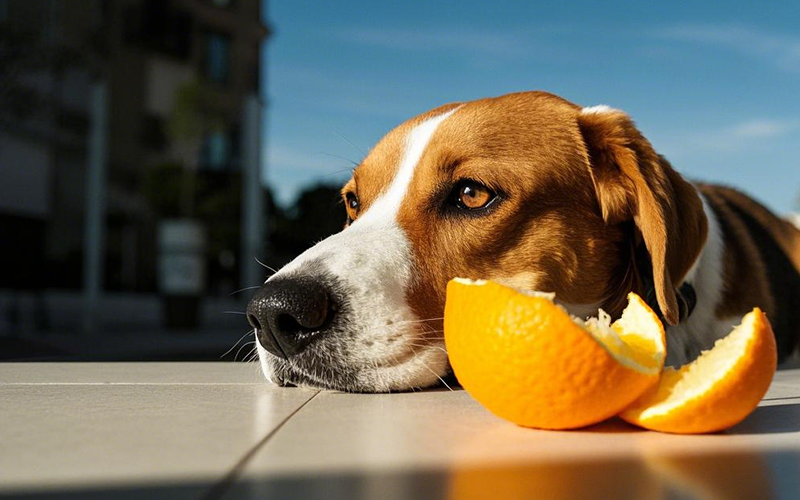Can Dogs Eat Orange Peels? What You Need to Know Before Sharing
- 15 Mar 2025 13:49
Oranges are a tasty and nutritious treat for humans, and it's tempting to share some with your furry friend. But when it comes to orange peels, can dogs eat them? While the flesh of an orange is generally safe for dogs in small amounts, the peels present a different story. Let’s explore why orange peels can be harmful to dogs and what you should do if your dog eats one. 🍊🐾

1. Are Orange Peels Safe for Dogs?
No, dogs should not eat orange peels. While the flesh of an orange contains vitamin C and is safe in small amounts, the peel is much more problematic. Orange peels are not toxic to dogs in small quantities, but they can cause digestive upset, choking hazards, or other health issues if consumed in larger amounts.
2. Potential Risks of Orange Peels for Dogs
Here are some reasons why orange peels are not a good choice for your dog:
Digestive Upset: Orange peels are difficult for dogs to digest and can cause gastrointestinal issues like vomiting, diarrhea, and stomach discomfort. The high fiber content in the peel is not suitable for a dog's digestive system.
Citrus Oils: Orange peels contain essential oils, like limonene, which can be irritating to your dog’s stomach and digestive system. In large quantities, these oils can cause toxicity, leading to symptoms such as drooling, lethargy, and confusion.
Choking Hazard: The peel’s tough, fibrous texture can be difficult for your dog to chew and could pose a choking risk. Larger pieces could get stuck in their throat or cause a blockage in their digestive tract.
Pesticides: Conventionally grown oranges may have pesticides on their skin. Even if you wash the peel thoroughly, some residue could still remain, which can be harmful to your dog.
3. Can the Flesh of an Orange Be Safe for Dogs?
Yes, the flesh of an orange is generally safe for dogs to eat in moderation. Oranges contain vitamin C, fiber, and antioxidants, which can provide some health benefits. However, because they are high in natural sugar, it’s important to limit your dog’s intake to prevent potential stomach upset or weight gain. A small piece of orange can make a healthy, refreshing snack for your dog, but don’t overdo it.
4. What to Do if Your Dog Eats Orange Peels
If your dog eats a small amount of orange peel, you don’t need to panic, but you should monitor them closely. Watch for signs of digestive upset, such as vomiting, diarrhea, or excessive drooling. If they consume a large quantity of orange peel or show signs of more severe symptoms like lethargy or confusion, it’s best to contact a pet health professional for advice.
5. How to Safely Offer Oranges to Your Dog
If you want to share some orange with your dog, make sure to follow these guidelines:
Peel the Orange: Always remove the peel before giving your dog a piece of orange. Only offer the fleshy part of the fruit.
Offer in Moderation: Oranges should be given in small amounts as an occasional treat, not as a regular part of your dog’s diet.
Watch for Allergic Reactions: While rare, some dogs may be allergic to citrus fruits. Watch for signs of discomfort like itching, swelling, or gastrointestinal upset after your dog eats orange.
6. Alternatives to Oranges for Dogs 🍎
If you’re looking for a healthy snack for your dog that is safe and nutritious, here are some good alternatives to oranges:
Apple Slices: Apples are low in calories, high in fiber, and rich in vitamins. Just be sure to remove the seeds and core, as they can be harmful to dogs.
Carrots: These are a great low-calorie snack that supports healthy teeth and digestion.
Blueberries: Full of antioxidants, blueberries are a great fruit choice for dogs when offered in moderation.
7. How PettureX Can Help You Monitor Your Dog’s Health
If you're ever unsure about what foods are safe for your dog, PettureX is here to help! PettureX is a pet AI assistant that offers 24/7 guidance on pet health, helping you make informed decisions about your dog’s diet. It also provides a useful image recognition tool to spot any health concerns in your dog’s behavior or diet. 🐕📱
8. Conclusion: Can Dogs Eat Orange Peels?
Orange peels are not safe for dogs and should be avoided. They can cause digestive issues, pose a choking hazard, and may contain harmful citrus oils or pesticides. However, the flesh of the orange is safe for dogs in moderation, as long as it is peeled and offered in small amounts. Always monitor your dog for any signs of discomfort after eating orange or any other new treat.
If you're ever unsure about whether a particular food is safe for your dog, PettureX can provide you with reliable answers and guidance to ensure your pet’s health and well-being. 🍊🐶
Related

Crunchy Curiosity: Can Dogs Safely Snack on Pork Rinds? A Deep Dive
- 21 Apr 2025
Pomegranate Seeds and Pooches: A Deep Dive into Whether Dogs Can Safely Indulge
- 21 Apr 2025
Can Dogs Eat Peaches? Vet Explains Benefits, Cyanide Risks & Safe Serving
- 16 Apr 2025
Can Dogs Eat Mulberries? Vet Explains Safety, Benefits & Potential Risks
- 16 Apr 2025
Can Dogs Eat Mozzarella? Vet Explains the Cheesy Truth (Risks & Benefits)
- 16 Apr 2025
Can Dogs Eat Maple Syrup? The Sugary Truth & Why Vets Advise Against It
- 16 Apr 2025
Can Dogs Eat Mango Skin? Vet Explains Why It's a Risky Chew!
- 16 Apr 2025
Can Dogs Eat Mac n Cheese? Vet Explains Why This Comfort Food Is Unsafe!
- 16 Apr 2025
Can Dogs Eat Liver? Vet Guide to This Nutrient-Dense Organ Meat (Benefits & Risks!)
- 16 Apr 2025
Can Dogs Eat Licorice? The Sweet Danger & Glycyrrhizin Risk Explained by Vets
- 16 Apr 2025
